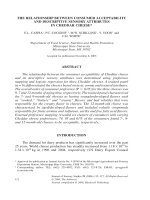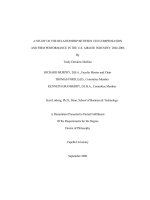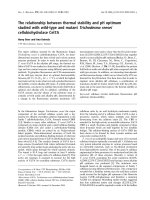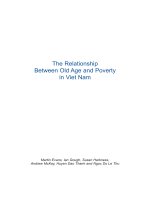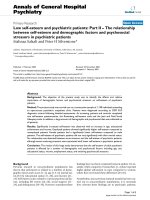Examining the relationship between bicultural stress and psychological well being among korean adolescents in singapore a mixed methods study
Bạn đang xem bản rút gọn của tài liệu. Xem và tải ngay bản đầy đủ của tài liệu tại đây (2.07 MB, 202 trang )
i
EXAMINING THE RELATIONSHIP
BETWEEN BICULTURAL STRESS AND
PSYCHOLOGICAL WELL-BEING
AMONG KOREAN ADOLESCENTS
IN SINGAPORE
: A MIXED METHODS STUDY
CHUNG, YOU-JIN
NATIONAL UNIVERSITY OF
SINGAPORE
2014
ii
EXAMINING THE RELATIONSHIP
BETWEEN BICULTURAL STRESS AND
PSYCHOLOGICAL WELL-BEING
AMONG KOREAN ADOLESCENTS
IN SINGAPORE
: A MIXED METHODS STUDY
CHUNG, YOU-JIN
B.A., M.A. (Social Work), Ewha Womans University
A THESIS SUBMITTED
FOR THE DEGREE OF
DOCTOR OF PHILOSOPHY
DEPARTMENT OF SOCIAL WORK
NATIONAL UNIVERSITY OF SINGAPORE
2014
i
DECLARATION
“I hereby declare that the thesis is my original work and it has been
written by me in its entirety.
I have duly acknowledged all the sources of information which have
been used in the thesis.
This thesis has also not been submitted for any degree in any university
previously.”
Chung, You-Jin
19 July 2014
ii
ACKNOWLEDGMENTS
Upon the completion of my PhD thesis, I must show my thankfulness to many
people.
I would like to express my heartfelt appreciation to Dr Mohanty, my
supervisor, for her constant encouragement and support, constructive guidance
and advice, and valuable comments at all stages of the research.
I also would like to express my gratitude to thesis committee members, Dr
Esther Goh and Dr Kang Yoonhee, who gave me valuable comments and
insightful feedbacks for this thesis.
I am especially thankful to Dr Rosaleen Ow, Head of Social Work Department
and many of the department’s faculty members for their encouragement and
friendship. I must also thank Ms. Boo Chui Ngoh, Ms. Suraya Bte Ahmad, Ms.
Lim Shan Shan, and Ms. Tan Ching Lin for their administrative support.
There are many others who have touched me in one way or another. Here I
would like to extend my gratitude and thanks to my Social Work mates, Dr Xu
Jian Bin, Dr Chan Cheong Chong, Ms Joan Khang, Dr. Peace Wong, Ms Teo
Poh Leng, Ms Corinne Ghoh, and Mrs Sylvia Mun. My special thanks to Mr
Kim Youngwan, Seongyoon, Jaeran, and Yeongyung for their dedicated help
for collecting the data. My sincere thanks to Hyunju, Jaejung, and my church
friends and students for their care, support, and love.
I am deeply indebted to my loved parents, my understanding husband Sang Uk,
and my lovely kids Jeong Eon and Han Bin. Throughout this pursuing of my
dream, they showed me their deepest understanding, unwavering
supportiveness, and love.
Last but not least, God, the Almighty, who have led and taught me at every
step during this journey, to whom I give my special thanks.
iii
TABLE OF CONTENTS
Declaration
I
Acknowledgments
ii
Table of contents
iii
Summary
vi
List of tables
viii
List of figures
ix
1 Introduction
1
1.1 Background and significance of the study
1.1.1 Korean adolescents in Singapore
1.1.2 Mixed methods approach
1
4
6
1.2 Research purpose and questions
7
1.3 Context of study
8
1.3.1 Migration policies in Singapore
9
1.3.2 Korean adolescents’ educational aspiration: Early Study
Abroad (ESA)
11
2 Review of literature
13
2.1 Determination of acculturation
14
2.1.1 Fourfold acculturation strategies and the context of the
receiving society
15
2.2 Bicultural stress during acculturation
17
2.2.1 Korean youths in the US
19
2.2.2 Asian immigrant youths in Asian countries
21
2.2.3 Bicultural stress in particular contexts
23
2.3 Bicultural stress and psychological well-being
27
2.3.1 Challenges: Bicultural stress and psychological well-being in
Singapore
28
2.4 Ethnic identity of immigrant adolescents
30
2.4.1 Social identity theory: intergroup relations
30
2.5 Ethnic identity and psychological well-being
33
2.5.1 Protective role of ethnic identity
35
2.6 Research objectives and hypotheses
38
2.6.1 Hypotheses
38
iv
3 Methodology
41
3.1 Pragmatism: Mixed methods assumption
41
3.1.1 Justification for using mixed methods
42
3.2 Research procedure: Exploratory sequential mixed methods
44
3.3 Mixed methods data analytic strategy
46
4 Study 1: Qualitative research
49
4.1 Participants
49
4.2 Focus group discussion
51
4.3 Sampling strategy and number of groups
52
4.4 Data collection
53
4.5 Data analysis
55
4.6 Findings
59
4.6.1 Ambivalence: Feeling superior but separate
59
4.6.2 Pressure to keep being a Korean from both sides
63
4.6.3 More traditional but less supportive
67
4.6.4 Less stress in speaking English, but more stress in learning
Chinese and keeping Korean: pressure to become a trilingual
69
4.6.5 Pride that “I am a Korean”: Confidence in ethnic identity
73
4.6.6 Being global: Confidence in both cultures
75
4.7 Discussion and implications of the quantitative study
77
4.7.1 “You are my special Korean friend”: Peer pressure
77
4.7.2 “Am I trilingual?”: Language stressor
80
4.7.3 Implications for selecting the measurement for the next
quantitative study
83
5 Study 2: Quantitative research
85
5.1 Sampling strategy and data collection
85
5.2 Measurements
87
5.2.1 Bicultural stress
87
5.2.2 Ethnic identity
95
5.2.3 Psychological well-being
96
5.2.4 Demographic information
98
5.3 Results
98
5.3.1 Descriptive results
98
v
5.3.2 Bivariate correlation for testing variables
102
5.3.2 Testing of moderating model
105
6 Discussion and implications
116
6.1 Experiences of bicultural stress
117
6.2 Ethnic identity of Korean adolescents in Singapore
120
6.3 Moderation effect of ethnic identity
117
6.4 Implications to theory
125
6.5 Implications for practice
127
6.6 Implications for policies in Singapore
129
6.7 Limitations and future research
133
6.6 Concluding remarks
135
7 Bibliography
138
8 Appendices
157
vi
SUMMARY
Adjusting to a new environment is particularly challenging for immigrant
adolescents, who are trying to adapt to two cultures while dealing with the
normal developmental process of identity formation. Hence, they generally
encounter stress during settlement. The stress perceived by immigrant
adolescents has aroused much interest in academic and practical areas because
it can negatively impact the psychological well-being of these adolescents.
However, the current understanding of how Asian immigrant adolescents
adapt to life in new Asian countries is limited despite the dramatic increase in
migration within Asia in recent years. The primary purpose of the present
study is to investigate the acculturation experiences of Korean immigrant
adolescents (age 13-18) in Singapore by exploring the stress they experience
and how they identify themselves during their settlement as well as the
moderation effect of ethnic identity on the relationship between bicultural
stress and psychological well-being (high self-esteem and fewer depressive
symptoms).
This study used an exploratory sequential mixed method. The
qualitative study found six themes related to stress and the identity formation
of these Korean adolescents in terms of peer, family, and the linguistic
contexts of Singapore: ‘ambivalence’, ‘pressure to keep being a Korean’,
‘more traditional but less supportive’, ‘pressure to become trilingual’,
‘confidence in ethnic identity’, and ‘confidence in both cultures’. Based on
these findings, measures were selected and modified where necessary for the
quantitative portion of the study to examine the moderating effect of ethnic
identity on the relationship between the bicultural stress and psychological
vii
well-being of Korean adolescent immigrants. The primary model testing in the
quantitative study showed that (a) bicultural stress negatively impacted
psychological well-being (i.e., it resulted in lower self-esteem and more
depressive symptoms) and (b) ethnic identity positively influenced
psychological well-being (higher self-esteem and fewer depressive symptoms).
However, contrary to the hypothesis, ethnic identity did not buffer the impact
of bicultural stress on psychological well-being. Rather, ethnic identity
enhanced the impact of stress on depression for Korean adolescents who
reported having a stronger ethnic identity.
The discussion focuses on integrating the qualitative and quantitative
study results. There are some challenges to understanding the role of ethnic
identity among Korean adolescents in Singapore: ethnic identity may not be a
salient issue for Korean adolescents with respect to protecting themselves
from ethic prejudice and discrimination in the Korean-favourable environment
in Singapore. Furthermore, developing ethnic identity may be a source of
stress for Korean adolescents, making them feel separated from their
Singaporean peers. In addition, not all minority youths experience negative
discrimination related to their ethnic background in a host society. Instead,
some immigrant youths experience positive discrimination by the majority
group in the receiving country. However this positive discrimination (or
positive stereotype) toward a particular ethnic group can be another source of
stress that immigrant youths need to handle during their settlement.
The present study helps identify further studies on the adjustment of
Asian immigrant youths in Asia.
(481 words)
viii
LIST OF TABLES
Table 1 Conceptual definition of study variables 40
Table 2 Profile of participant of FGD 55
Table 3 Theme and axial codes 58
Table 4 Theme, axial codes and new items of stress 90
Table 5 Exploratory factor analysis 94
Table 6 Sample characteristics 100
Table 7 Bivariate Correlation of testing variables 104
Table 8 Moderating effects on self-esteem using hierarchical multiple
regression 108
Table 9 Moderating effects on depression using hierarchical multiple
regression 110
Table 10 Conditional effect of bicultural stress at level of ethnic identity
112
Table 11 Conditional effect of bicultural stress at level of ethnic identity
114
Table 12 Conditional effect of bicultural stress at level of ethnic identity
115
ix
LIST OF FIGURES
Figure 1 Hypothesis moderation effect of ethnic identity on the relationship
between bicultural stress and psychological well-being 39
Figure 2 Flowchart of the procedure of exploratory sequential research 45
Figure 3 Mixed methods data analytic procedures 48
Figure 4 Moderating effect of ethnic identity on depression 112
Figure 5 Moderating effect of ethnic identity on depression 114
x
1
CHAPTER 1
INTRODUCTION
1.1 BACKGROUND AND SIGNIFICANCE OF THE STUDY
Adjusting to a new environment can be particularly challenging to immigrant
adolescents who are trying to adapt to two cultures, their heritage culture and a
host culture, while navigating the developmental process of identity formation.
Hence, some immigrant adolescents may experience stress during settlement
(Berry, 1997; 2003). Studies have found that this stress negatively impacts
immigrant adolescents’ psychological well-being, resulting in low self-esteem,
depressive symptoms, low self-satisfaction, and other psychological symptoms,
such as anxiety and suicidal ideation (Altiynelken, 2009; Berry, Phinney, Sam
& Vedder, 2006; Cho & Haslam, 2010; Hovey & King, 1996; Juang, 2009;
Lee, Koeske & Sales, 2004; Suarez-Morales & Lopez Babara, 2009).
Furthermore, some research has suggested that Asian immigrant adolescents
are more vulnerable to psychological maladjustment in a bicultural context
due to limited social interaction, communication barriers, discrimination
experiences, and less social support compared with European or Latino
adolescents (Lin & Yi, 1997; Lorenzo, Pakiz, Reinherz, & Frost, 1995; Yeh,
2003; Yeh & Inose, 2003). Most studies have focused on stress experienced by
2
Asian immigrants in Western countries, such as the United States (US), the
United Kingdom (UK), Canada, and Australia; little is known about their
experiences in Asia, specifically, in Singapore, one of the main migrant-
receiving countries in Asia.
In understanding the negative impact of stress on Asian immigrant
adolescents’ well-being, some studies have examined the protective role of
ethnic identity in ameliorating the impact of this stress (Chan & Owens, 2006;
Lee, 2005; Shelton, Yip, Eccles, Chatman, Fuligni & Wong, 2003). Phinney
(1990) and Tajfel (1982) state that for ethnic minorities, developing a positive
sense of ethnic identity not only provides a sense of pride, belongingness, and
security but also enables them to better cope with racial-/ethnic-related stress
and conflicts derived from a bicultural context. For example, Lee (2005) found
that Korean college students with high ethnic pride showed relatively fewer
depressive symptoms than Korean students with low ethnic pride when they
perceived ethnic discrimination in the US. Similarly, Yip and Fuligni (2002)
found that Chinese adolescents with a strong ethnic identity reported less
anxiety compared with those with a weak ethnic identity when they
experienced bicultural stress during settlement in the US.
The stress that immigrant adolescents experience may differ in
different cultural contexts due to similarities or differences between the
immigrants’ heritage culture and the dominant culture of the host society
(Berry, 2006; Hsiao & Wittig, 2008; Romero, Carvajal, Valle & Orduna,
2007). A few studies have shown that the findings of studies conducted in
Western countries may not adequately represent the experiences of Asians
who settle in Asian countries where the host countries and their originating
3
countries are closely connected, both geographically and culturally (Chung &
Mohanty, 2014; Wong et al, 2004). For example, adolescents from mainland
China who settled in Hong Kong faced some difficulties mainly due to the
different attitudes of their peers in the local school context; this stress
negatively impacted their mental health (Wong et al, 2004). Although Asian
culture is known to be similar across countries in terms of collectivism
compared to individualism in Western culture, it is important to acknowledge
that there exists a multitude of significant differences in cultural values,
cultural practices, customs, languages, and religions among different regions
of Asia (Hugo, 2006); hence, the need for this study. Studies that have been
conducted in Singapore have mainly focused on adult migrants (e.g. migrant
workers’ rights) or immigration policy (e.g. social cohesion/integration issues)
(Liu, 2014; Lyons & Yee, 2009; Reid, 2010; Rubby & MacKay, 2013), but
less is known about Asian immigrant adolescents’ experiences and how that
relates to their psychosocial development.
During the last decade, the number of immigrants within Asia has
increased by 20 percent (United Nations, 2011). Around the same time, the
proportion of foreigners in Singapore has risen to almost 25 percent of the
total population (Department of Statistics Singapore, 2011). In particular, the
number of Koreans in Singapore has rapidly increased. There are an increasing
number of pre-college students who come due to their academic aspirations,
and Singapore’s policy attracts foreign students from across Asia (Huang &
Yeoh, 2005). As a result, the number of Korean students attending public/local
schools has grown by 30 percent between 2004 and 2008 (Lee, 2008).
Therefore, this study focuses on Korean immigrant adolescents in Singapore.
4
1.1.1. Korean adolescents in Singapore
In addition to the fact that Korean youth is one of the fastest growing ethnic
groups in Singapore, this study intentionally selected Korean adolescents from
among other Asian immigrant youths for several other reasons. First, previous
studies, mostly conducted in the US, have reported that Korean adolescents
experience a higher level of mental health symptoms such as depression and
anxiety during settlement compared with other Asian ethnic groups, such as
the Chinese and Japanese (Jang, 2013; Yeh 2003). This is mainly due to
cultural conflicts with parents, feelings of alienation and exclusion from the
mainstream cultural group, and racial discrimination by their white peers (Cho
& Bae, 2005; Kim, Huh & Kim, 1993; Lee & Cynn, 1991). Second, little
attention has been directed toward Korean youths in the Singapore context,
and the overall size of studies focused on this population is still quite small.
For example, only a few existing studies have described the transnational
schooling experiences of Korean families by conducting interviews with the
mothers (Kim, 2010; Niedermeyer, 2008). Therefore, Korean adolescents’
stress and adjustment have not been properly explored.
Furthermore, Korean adolescents’ interactions in the Singapore context
may differ from that reported by existing studies in Western countries.
Although Singapore is well-known as a multicultural society this country
mainly comprises different Asian ethnic groups
1
, unlike other traditional
1
According to the Singapore Department of Statistics (2014), the Chinese remained
as the majority at 74 percent of the resident population, followed by Malays with 13
percent, Indians with 9.1 percent, and other ethnic groups with 3.3 percent.
5
destinations such as the US and Canada. In addition, it is difficult to identify a
single mainstream culture in Singapore that immigrants are expected to
acculturate into. This might be because Singapore’s multiculturalism is based
on the CMIO (Chinese-Malay-Indian-Others) model, which maintains the
differences and boundaries among ethnic groups (Amwer, 2014). Consistent
with this stance, immigrants are expected to maintain their own cultural
practices, traditions, and mother language without the pressure to acculturate
to a dominant culture.
Additionally, there are a certain cultural differences between Singapore
and Korea to be considered despite the fact that both countries have been
classified as collectivistic and Confucian Asian countries in most of the
migration research. Compared with multicultural and multilingual Singapore
society, Korea is one of the few countries in which ethnicity and nationality
coincide. It has its own language (known as ‘Hangeul’) and traditional cuisine
(‘Hansik’), dress (‘Hanbok’), and etiquette, separate and distinct from its
neighbouring countries, such as China and Japan. Moreover, Koreans value
their homogeneous cultural tradition (known as ‘Han Minjeok’), which most
Korean people throughout the country share (Korea Tourist Organization,
2014). Another significantly different aspect is the percentage of foreign
residents: although an increasing number of foreigners have immigrated to
Korea during the last decade, foreign residents only make up 3 percent of the
Korean population, which is much lower than the 25 percent found in
Singapore (Korean Statistical Information Service, 2014; Department of
Statistics Singapore, 2011). In particular, in Korea, immigrant adolescents who
attend the local schools are reported to be less than 1 percent of the total
6
number of school students. Hence, there are few opportunities for adolescents
to experience other cultures when living in Korean society.
Given that the Singapore context is culturally and socially different
from both other Western countries and Korean society, this raises the question
of what types of stress Korean youths face in their settlement experiences. In
order to obtain a comprehensive understanding of Korean adolescents’ stress
in Singapore and its impact on their psychological well-being, it is necessary
to adopt the mixed method of qualitative and quantitative approaches.
1.1.2 Mixed methods approach
In the field of immigration, most researchers have taken either a qualitative or
a quantitative approach in understanding the acculturative experiences of
immigrant adolescents. While each approach has its strengths, using a single
method may have some limitations when investigating Korean adolescents’
stress and its impact on their psychological well-being in the context of this
study.
A purely quantitative approach using standardised measurements
developed in Western culture may inadequately assess the cultural aspects of
the particular context of this study due to the lack of cross-cultural validity
between Asian and Western cultures (Plano Clark, Huddleston-Cases,
Churchill, Green & Grrett, 2008). In other words, Korean adolescents in
Singapore may experience stress dissimilar to that experienced by Korean
adolescents in Western countries because stress caused by acculturation is
culturally specific (Van Oudenhoven, Prins & Buunk, 1998). Hence,
7
integrating a qualitative approach is essential when exploring the stress
Korean adolescents experience in their interaction with Singapore society, a
topic that has not been sufficiently researched. On the other hand, a single
qualitative approach may be limited to examining the relationship between
stress and ethnic identity and how that relates to the well-being of Korean
adolescents in Singapore.
In light of this, the mixed methods approach is the most suitable
methodology for this study. To my knowledge, this is the first empirical study
to explore Korean immigrant adolescents’ stress and examine the role of
ethnic identity on their psychological well-being in Singapore using a mixed
methods approach.
1.2 RESEARCH PURPOSE AND QUESTIONS
The primary purpose of the present study is to investigate the experiences of
Korean immigrant adolescents in Singapore using exploratory sequential
mixed methods: exploring their stress and identity formation, and then
examining the protective role of ethnic identity on their psychological well-
being. This exploratory as well as explanatory study is expected to contribute
to a better understanding of how stress and ethnic identity influence and
interact with immigrant adolescents during their acculturation process in Asia.
To achieve the purpose of this study, the following research questions
were thoroughly investigated.
8
1. What stress do Korean adolescents experience during acculturation
in Singapore?
2. How do Korean adolescents perceive and cope with the demands of
this stress?
3. How do Korean adolescents identify themselves in the context of
Singapore?
4. What can we learn from Korean immigrant adolescents’ reflections
on stress and identity by exploring their perception of experiences?
5. What is the relationship between bicultural stress, ethnic identity,
and psychological well-being among Korean adolescents in Singapore?
In the following sections, the context of this study is explained,
including the new trend of migration within Asia, the immigration policies and
practices of Singapore, and the background of Korean immigrant adolescents.
1.3 CONTEXT OF STUDY
Migration in Asia has increased dramatically in recent years, rising from
approximately 50.9 million people migrating within Asia in 2000 to
approximately 61.3 million in 2010 (United Nations, 2011). The majority of
foreign immigrants in Asia come from other Asian countries (Martin, 2009;
United Nations, 2012). In Southeast Asia, for example, intra-migration within
the region increased by 37 percent between 2000 and 2005, from 4.1 million to
9
5.6 million (Castles, 2009). In particular, fast-growing newly industrialized
countries such as Singapore, Hong Kong, South Korea, Japan, and Taiwan
have become more attractive places for Asian migrants. One of the reasons for
this relatively new social phenomenon is the fast economic growth in these
countries. Since the mid-1980s, rapid economic growth and declining fertility
rates have led to a large demand for labour, drawing immigrants to these
countries (Yeoh, 2004). Another possible explanation is the new trend of
mobility of highly qualified migrants and international students within Asia
(Castles & Miller, 2009).
1.3.1 Migration policies in Singapore
Singapore is a multicultural and multilingual society that includes Chinese,
Malay, Indian, and other minority ethnic groups. One of the contributors to
population growth in this country has been a migration surplus (Yeo, 2004).
Within this historical context, the size of the foreign population has rapidly
grown during the last two decades. The data from Singapore’s Department of
Statistics (2011) reveal that the foreign population increased from 10.2 percent
to 25.7 percent of the total population between 1990 and 2010, a 9.3 percent
expansion per year. This figure shows a more rapid growth rate as compared
with a rate of 1.8 percent per year in the number of Singapore citizens and
permanent residents (PRs). There are three main groups of foreigners attracted
to Singapore: ‘low-skilled contract workers’, ‘skilled professional and
managerial workers in high-end positions’, and international students; these
10
migrants mostly come from other Asian countries, such as Malaysia, China,
Hong Kong, Indonesia, and some countries in South Asia (Yeoh & Lin, 2012).
The most rapid increase in the foreign population occurred in the
labour force of Singapore. Foreign-born manpower, including high- and low-
skilled workers, has increased from 28.1 percent in 2000 to 34.7 percent in
2010. Overall, this population has grown 76.8 percent, from 615,700 in 2000
to approximately 1.09 million in 2010 (Department of Statistics, 2011). The
demand for low-skilled foreign workers, in particular, seems to be increasing
because the education and socio-economic levels of Singaporeans have been
raised over time. Singaporeans are reluctant to take on low-skilled or low-paid
jobs in construction, manufacturing industries, or domestic service (Yeoh &
Lin, 2012). The other burgeoning sector of foreign manpower is mainly from
the US, the UK, and Australia, as well as Japan and South Korea. In the early
2000s, the foreign population was bolstered by policy changes, encouraging
immigration from more ‘source countries’, such as China and India. This
social phenomenon could be partly attributed to the Singapore migration
policy, ‘Talent Capital’, which attempts to attract more talented or high-skilled
personnel to build Singapore’s image as a multicultural ‘Renaissance City’
(Yeoh, 2004).
The third immigration group is that of international students. In
particular, due to the policy of branding Singapore as an ‘Asian Education
Hub’ and ‘Global Schoolhouse’, the number of foreign students in Singapore
has increased more than two-fold, from about 66,000 in 2005 to 150,000 in
2012 (Huang & Yeoh, 2005; Yeoh & Lin, 2012). Since 1997, the Singapore
government has recruited foreign students from other areas of Asia, such as
11
China, India, and South Asia, and has continually made an effort to designate
an ‘art and learning hub’ and emphasize Singapore’s strength in having the
‘best combination of Asian and Western education systems’ (Yeoh & Lin,
2012).
From the reports and statistics presented above, immigration seems to
have become a more crucial feature in the dynamics of the Singapore
population. Recently, the Singapore government set up prominent programs to
manage the immigration policy, such as the ‘National Integration Council and
Integration Fund’ in 2009 and the ‘Integration and Naturalisation Champion’
(INC) program in 2011 (Kang, 2012). These migration policies and programs
aim to encourage both immigrants and Singapore citizens to integrate
harmoniously into the society and make up one nation comprised of multiple
ethnic/cultural groups.
1.3.2 Korean adolescents’ educational aspirations: Early Study Abroad
(ESA)
In line with Singapore’s immigration policies, the Korean population in
Singapore has increased noticeably in recent years. According to the Ministry
of Foreign Affairs of the Republic of Korea (2009), the size of the Korean
community in Singapore increased by 80 percent between 2005 and 2007. In
particular, the number of Korean pre-college students in Singapore has grown
tremendously in the last few years. The Korean Embassy in Singapore
reported that approximately 3,500 Korean students under the age of 18 were
estimated to be studying in Singapore in 2007, and this number increased to
12
6,500 in 2008
2
. This phenomenon is not only related to Singapore’s
immigration policies but also reflects a new social trend of academic
aspirations in Korea. Many young Korean adolescents, also known as ‘Early
Study Abroad’ (ESA) students, relocate to English-speaking countries for their
pre-college education in response to the wave of globalization (Kang, 2010).
Since 1990, a growing number of Korean students have moved to the US, the
UK, Canada, Australia and New Zealand. The number of Korean students
going abroad has increased almost 17-fold from 1,562 in 1998 to 27,349 in
2007 (Kang & Abelmann, 2011). Over the last decade, Korean adolescent
immigrants have been present in English-speaking countries within Asia.
Singapore has become one of the most attractive and popular countries for
students who desire to learn two significant world languages, English and
Mandarin (Kang, 2010).
Having discussed the context of this study in relation to the
acculturation experiences of Korean adolescents, the next section defines
bicultural stress and ethnic identity using the bi-dimensional acculturation
model (Berry, 2003) and Tajfel’s social identity theory. Special emphasis will
be placed on how ethnic identity moderate the impact of bicultural stress on
the psychological well-being of immigrant adolescents.
2
Statistics for the number of Korean students living in Singapore were not provided
by the Singapore government. These estimates were extracted from the Korean
Herald (16 April, 2008) and Channel News Asia (10 February, 2008).
13
CHAPTER 2
REVIEW OF LITERATURE
This chapter presents literature pertinent to studies on immigrant adolescents’
bicultural stress and ethnic identity. As indicated earlier, much of the literature
on stress and identity formation has focused on immigrant adolescents in
Western countries, mostly in the US, and only a few studies have been
conducted in Asian regions (Chung & Mohanty, 2014; Lam & Chan, 2004;
Wong et al, 2004). Acculturation experiences could be different depending on
the context where immigrant adolescents settled in. Hence, it is worthwhile to
look at existing literature to get a clear insight into how the context interacts
with immigrant adolescents during their settlement by comparing two cultural
backgrounds: Western and Asian contexts. By reviewing empirical studies
done in both cultural contexts, and two theoretical perspectives – the bi-
dimensional acculturation model (Berry, 1997; 2003) and Tajfel’s social
identity theory (1982), the conceptual framework and hypotheses were
constructed to articulate the relationship between bicultural stress, ethnic
identity, and the psychological well-being of Korean immigrant adolescents in
Singapore.

